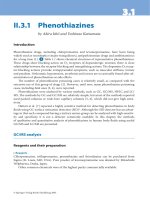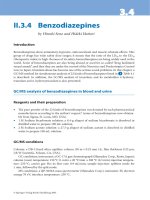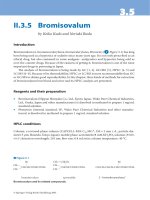Tài liệu Policy and Politics in State Budgeting pptx
Bạn đang xem bản rút gọn của tài liệu. Xem và tải ngay bản đầy đủ của tài liệu tại đây (2.45 MB, 398 trang )
Policy
and
Politics
in
State
Budgeting
Bureaucracies, Public Administration,
and Public Policy
Kenneth J. Meier
Series Editor
THE STATE OF PUBLIC
BUREAUCRACY
Larry B. Hill, Editor
THE POLITICS OF DISSATISFACTION
Citizens, Services, and Urban Institutions
W. E. Lyons, David Lowery, and
Ruth Hoogland DeHoog
THE DYNAMICS OF CONFLICT
BETWEEN BUREAUCRATS AND
LEGISLATORS
Cathy Marie Johnson
THE POLITICS OF
TELECOMMUNICATIONS
REGULATION
The States and the Divestiture of AT&T
Jeffrey E. Cohen
WOMEN AND MEN OF THE STATES
Public Administrators at
the State Level
Mary E. Guy, Editor
ETHICS AND PUBLIC
ADMINISTRATION
H. George Frederickson, Editor
ENVIRONMENTAL PROTECTION AT
THE STATE LEVEL
Politics and Progress in
Controlling Pollution
Evan J. Ringquist
THE POLITICS OF SIN
Drugs, Alcohol, and Public Policy
Kenneth J. Meier
ELECTORAL STRUCTURE AND
URBAN POLICY
The Impact on Mexican American
Communities
J. L. Polinard, Robert D. Wrinkle,
Tomas Longoria, and Norman E. Binder
CONTROLLING THE BUREAUCRACY
Institutional Constraints in Theory
and Practice
William F. West
FLIRTING WITH DISASTER
Public Management in Crisis Situations
Saundra K. Schneider
ENFORCING THE LAW
The Case of the Clean Water Acts
Susan Hunter and Richard W. Waterman
EXECUTIVE GOVERNANCE
Presidential Administrations and Policy
Change in the Federal Bureaucracy
Cornell G. Hooton
THE PROMISE OF REPRESENTATIVE
BUREAUCRACY
Diversity and Responsiveness in
a Government Agency
Sally Coleman Selden
DOWNSIZING
THE FEDERAL GOVERNMENT
The Managaement of Public Sector
Workforce Reductions
Vernon Dale Jones
THE AMERICAN EXPERIMENT WITH
GOVERNMENT CORPORATIONS
Jerry Mitchell
Kurt M.Thurmaier and
Katherine G. Willoughby
Policy
and
Politics
in
State
Budgeting
M
.E.Sharpe
Armonk, New York
London, England
Copyright © 2001 by M. E. Sharpe, Inc.
All rights reserved. No part of this book may be reproduced in any form
without written permission from the publisher, M. E. Sharpe, Inc.,
80 Business Park Drive, Armonk, New York 10504.
Library of Congress Cataloging-in-Publication Data
Thurmaier, Kurt M., 1957–
Policy and politics in state budgeting / by Kurt M. Thurmaier and Katherine G.
Willoughby.
p. cm. — (Bureaucracies, public administration, and public policy)
Includes index.
ISBN 0-7656-0293-8 (alk. paper)
1. Budget—United States. I. Willoughby, Katherine G., 1958– II. Title.
III. Series.
HJ2053.A1 T48 2001 00-053160
352.4’8213’0973—dc21 CIP
Printed in the United States of America
The paper used in this publication meets the minimum requirements of
American National Standard for Information Sciences
Permanence of Paper for Printed Library Materials,
ANSI Z 39.48-1984.
BM (c)10987654321
We dedicate this book
to Dan H. Willoughby, Jr., and
to the memory of Roland J. Thurmaier
This page intentionally left blank
vii
Contents
List of Tables, Figures, and Boxes xiii
Preface xv
Acknowledgments xix
Acronyms xxi
Chapter 1. Introduction 3
The Purpose of This Research 3
The State Government Setting: Factors Influencing Budgeters’
Decisions 7
Financial Condition 7
Political Factors 8
Organizational Setting of the State Budget Office 12
Personal Characteristics of Budget Examiners 15
State Sample Characteristics 16
Fiscal and Economic 16
Politics, Budget Powers, and Organizational Factors 17
Comparison of the Sample States 20
Interview Methodology 22
Summary: Using This Text Effectively 27
Chapter 2. The State Budget Office and the Budget Problem 30
The Budget Problem: Funding Policies and Programs 30
The Governor’s Budget and Policy Problems 31
Policy Change and the Agenda-Setting Model 34
PAS and State Policy-Making 40
The Treatment of Time and Timing in Decision Models 44
Synthesis of Change Models 46
Incrementalism Models 47
GCM–RTB–Incrementalism Synthesis and Implications 49
viii CONTENTS
The Budget Decision Agenda 52
The SBO as Gatekeeper 54
Flows of Information 57
Top–Down Flows 57
Bottom–Up Flows 59
Coupling Macro and Micro Decisions 59
Development-Phase Decisions 62
The First Decision Level 62
The Second Decision Level 65
The Third Decision Level 66
Execution-Phase Decisions 66
Summary: The Foundations for a Model of Budget Rationality 67
Chapter 3. Budget Rationalities: Effectiveness Decisions 70
Why Propose a Budget Rationalities Model? 70
Is There Such a Thing as Budget Rationality? 71
Toward a Concept of Budgetary Rationality: The Limits
of the ECM 72
Demands of a Model of Budget Rationality 77
Empirical Support for a Model of Budget Rationality 79
Effectiveness Decisions 81
Social Rationality 82
Political Rationality 86
Budget Process: Decision-Making Structures Associated
with Political Rationality 87
Choosing Peripheral Policies and Programs 89
Political Feasibility Frontier 90
The Politics of Substantive Policy Areas 92
Legal Rationality 94
Summary: Conclusions About Effectiveness Decisions 96
Chapter 4. Budget Rationalities: Efficiency Decisions 98
The Efficiency/Effectiveness Cleavage 98
Efficiency Decisions 99
Economic Rationality 99
Technical Rationality 101
The Limitations of Efficiency Decisions 102
The Rationalities Framework 104
Multiple Rationalities at Work 107
Problem Framing: Simplifying Decision Rules to
Reduce Complexity 109
CONTENTS ix
The Rational Analyst and Budget Rationality 109
Budget Problem Representation: Framing Decisions 110
The Credibility of the Issue Framer 118
A Multidimensional View of the Budget Problem 120
Summary: Complex Problems Require Complex Analysis 124
Chapter 5. Budget Office Orientations and Decision Contexts 129
A Typology of Budget Office Decision Contexts 129
Gubernatorial Activism and Policy Influence 131
SBO Orientations 133
Midwestern States 133
Control Orientation 137
Weak Policy Model 139
Strong Policy Model 141
Southern States 145
Control Orientation 148
Transition (Weak Policy) Model 150
Strong Policy Model 151
Policy Distances in State Budgeting 153
Policy Consonance and Priorities 154
Working for the Governor 155
Nurturing a Policy Orientation 159
Affirmation Rates of Examiners 163
Patterns of Communication Flow in SBOs 166
Summary: Policy Problems Become Budget Problems in a
Decision Context 170
Chapter 6. The Anatomy of a Policy-Oriented Budget
Recommendation 173
Shadowing the SBO Examiner 173
The Task of the Policy-Oriented SBO 174
Predevelopment-Phase Analysis 176
Social Facets of Budget Problems 179
Political Facets of Budget Problems 187
Legal Facets of Budget Problems 199
The Effectiveness Framework and Efficiency Rationalities 203
Development-Phase Analysis 206
Technical Rationality 207
Economic Rationality 209
Crafting the Examiner’s Recommendation 211
Simplifying Decision Rules 217
x CONTENTS
Briefing the Governor 221
Control in Policy-Oriented SBOs 233
A Note About Legislative-Phase Analysis 234
Summary: A Decision Process with Multiple Rationalities 235
Chapter 7. The Anatomy of a Control-Oriented Budget
Recommendation 236
The Task of the Control-Oriented Office 236
Predevelopment-Phase Analysis 239
Social and Legal Facets of Budget Problems 239
Talking with Agency Personnel 243
Making Site Visits 246
Political Facets of Budget Problems 249
Agency Priorities 250
SBO Priorities: Communicating with the Section Manager 251
Gubernatorial Priorities 253
Budget Hearings 256
Development-Phase Analysis 257
Receiving the Agency Budget Request 257
The Revenue Constraint 259
Crafting a Recommendation 260
Summary: Constraints on a Multiple-Rationalities Approach
to Budget Decisions 265
Chapter 8. Changing Roles: From Guarding the Purse to
Guarding the Policy 267
Historical Evolution of the Budget Examiner Role 267
The Roles Typology from Examiner Interviews 274
Adversary 276
Conduit 280
Facilitator 281
Policy Analyst 283
Advocate 291
The Issue of Neutral Competency 294
Examiner Role Complexity 296
A Model of Budgetary Roles 301
Different Budget Phases Require Different Examiner Roles 303
Different Decision Contexts Require Different Roles 305
Examiner Roles in a Policy-Oriented SBO 310
Examiner Roles in a Control-Oriented SBO 316
CONTENTS xi
Compare and Contrast: Control- Versus Policy-
Oriented SBOs 320
Educational and Professional Backgrounds of
Budget Examiners 324
Different Roles Require Different Types of Decision-Making 327
Decision Context Matters 330
Relationships Matter 331
Summary: Decision Context, Communication, and Budget
Roles of SBOs 333
Chapter 9. Conclusion 335
Why Examine Examiners? 335
Methodology, Sample States, and Decision Environment 337
Characterization of SBO Contexts on a Control-Policy
Continuum 340
Research Questions Answered 343
Current Contextual Considerations 347
Future Research Activities 349
Summary: Enlightening Decision-Making in SBOs 350
References 351
Index 363
About the Authors 375
This page intentionally left blank
xiii
List of Tables, Figures, and Boxes
Tables
1.1 State Budget Office Functions in the United States 13
1.2 1994 General Fund Revenues, Expenditures, and Debt per Capita
by State 18
1.3 Number of Budgeters Interviewed by State Budget Office 23
1.4 Interviews of Budgeters by State and Supervisor Level 24
5.1 Distribution of Orientation Responses in Midwest State Budget
Offices 134
5.2 Distribution of Orientation Responses in Southern State Budget
Offices 147
5.3 Frequency of Gubernatorial Briefings by State 156
5.4 For Whom Do You Work? By State, Only Examiners and Section
Managers 160
5.5 For Whom Do You Work? By Frequency of Governor’s Briefings 162
5.6 Mean Affirmation Rates by Supervisor Level 164
8.1 Role Identifications for Examiners in Eleven State Budget
Offices 296
8.2 Average Number of Roles, by Role Type, by State 297
8.3 Roles and Roles Scores by State 306
8.4 Mean Total Roles Scores by State 308
8.5 ANOVA and Tamhane Tests, Total Roles Scores and Orientation 309
8.6 Mean Roles Index by SBO Orientation 310
8.7 Spearman’s Correlations of Examiner Backgrounds and Roles 311
8.8 Distribution of Bachelor’s Degrees by Type, by Level of Roles 326
9.1 Factors Affecting the Strength of the Governor 338
xiv LIST OF TABLES, FIGURES, AND BOXES
Figures
1.1 Budget Examiner Interview Protocol 25
2.1 The State Budget Office Decisions Nexus 61
3.1 Political Feasibility Frontier 91
4.1 Value Preference Intensity of a Typical Agency Program 115
4.2 Budget Problem Framing with Multiple Rationalities 121
4.3 Subset of Alternatives Feasible Politically and Technically 123
4.4 Identifying the Subset of Feasible Alternatives from a Multiple
Rationalities Decision Framework 124
5.1 A Schematic Presentation of SBO Orientation Patterns in Six
Midwestern States 137
5.2 A Schematic Presentation of SBO Orientation Patterns in Five
Southern States 148
5.3 Large Policy Distance (Strong Control) Model 167
5.4 Intermediate Policy Distance (Weak Policy) Model 169
5.5 Short Policy Distance (Strong Policy) Model 170
6.1 The Budget Process 174
8.1 Distribution of Roles by Roles Type 299
8.2 A Model of Budgetary Roles and Decision-making 302
8.3 Examiner Roles in a Policy-Oriented SBO 313
8.4 Examiner Roles in a Control-Oriented SBO 318
8.5 Comparison of Examiner Roles in Control- and Policy-
Oriented SBOs 321
9.1 SBO Orientation: SBO Placement Along Control-Policy
Continuum 342
Box
2.1 The Garbage Can Model 35
xv
Preface
This book accomplishes two goals. First, it provides an in-depth description
of budgetary politics and policy-making in state budget offices. The data
rendered in these chapters fills a significant gap in our understanding of state
budget processes, and how budgeting and policy-making are linked in state
budget offices. Except for a few important attempts in the early 1960s, very
little is written about state budget office activities, which is surprising given
their crucial position at the nexus of budgeting and policy-making in many
states. The stories we tell here help public administration and political sci-
ence scholars understand how we get collective budgetary choices, how state
budget examiners influence those choices, and how these examiners make
decisions to influence budgetary choices.
The second goal of this book is to present a descriptive model of the
decision-making processes of state budget examiners, a model that we be-
lieve has significant implications for the larger effort to create a corpus of
budget theory that has positive and normative validity. The lack of a widely
accepted budgetary theory of decision-making is no small matter for schol-
ars and students alike. With a few notable exceptions, budgeting scholars
seem to be gun-shy about proposing models of budgetary decision-making.
This has been especially problematic at the microbudgeting level, where such
a void has been increasingly filled by residual applications of microeconomic
decision-making models that portray bureaucrats as self-interested and util-
ity maximizing. The model proposed in this book rejects simplistic assump-
tions of bureaucratic behavior and presents a decision-making model that
accounts for multiple rationalities as the basis for budget and policy deci-
sions by state budget examiners. Budget examiners themselves, in this case
those in the eleven state budget offices included in our field study, provide
substantial evidence of this model.
We wrote this book with three audiences in mind. Scholars of state bud-
xvi PREFACE
geting, state policy-making, and state politics should find this book a useful
addition to their libraries. The model we construct weaves budgeting, policy,
and politics together, highlighting the actors, the decision points, and the
nexus of budgeting and policy-making in state budget offices. The state poli-
tics literature has lacked any significant study of how budgetary politics fits
into the larger policy process with respect to the governors, and this book
will fill that void as well. Research colleagues in the fields of public admin-
istration and political science will find this research highly valuable in con-
tributing to a continuing academic discussion about how we get the collective
budgetary choices we do, and the role that budget examiners play in influ-
encing those choices.
Students of public administration, public policy, and political science will
find this book useful as well. It is particularly well suited to two types of
courses. First, graduate courses in public budgeting and policy analysis will
benefit greatly from the book’s focus on microbudgetary decision processes.
It is an excellent complement to macrolevel books on budgeting (e.g., Rubin’s
Politics of Public Budgeting) and general textbooks (e.g., Lee and Johnson’s
Public Budgeting Systems). These kinds of books help students see the over-
all process of budgeting but gloss over how individuals make budgeting de-
cisions and contribute to final budget outcomes. Students can identify with
the ideal type of examiners and their work in state budget offices as pre-
sented in the second half of this book, and can follow examiners’ “thinking”
as they develop budget recommendations for their respective governors.
Students in state politics courses will also benefit from this book. It high-
lights how governors use budgets as policy instruments, identifying both the
nexus and the distinctiveness of state politics and state policy-making. The
book enriches our understanding of the policy-making process in states and
particularly highlights the policy influence of a key set of actors (budget
examiners) who often have been either ignored or lumped carelessly with
the “governor’s office.” For example, we identify some important differ-
ences between the decision-making of state budget examiners and that of
members of the governor’s policy staff. The politics of budgeting is influ-
enced by both sets of actors.
The third audience for this book is the retinue of public servants engaged
in state budgeting in various agencies, state budget offices, and state legisla-
tures. The results of our field study of state budget offices in two different
regions of the United States provide practitioners of state budgeting with an
important window into the “black box” of budgetary decision-making in
state budget offices. We demonstrate how budget examiners develop their
budget recommendations for the governor. We identify the important differ-
ence it makes for examiners (and governors) when the budget office has a
PREFACE xvii
stronger policy rather than control orientation. The results reported here also
encourage agency budgeters and state budget examiners to have open and
cooperative relationships that support a mutual goal of advancing the effec-
tiveness of agency programs. The personal relationships between these bud-
get actors are critical factors in the way budget office recommendations are
fashioned for the governor.
Of the third audience, this book is especially useful for governors who
wish to make the budget and the budget office into more effective policy
instruments. To the extent that a governor desires to change the role of the
budget office and the budget examiners employed therein, this book pro-
vides some footprints to follow with respect to the relationships between the
governor, the budget director, and the budget examiners. It highlights the
impact of a personal relationship between the governor and examiners, and
how that relationship does not require examiners to compromise their “neu-
tral competency” in an effort to provide more effective budget and policy
recommendations to the governor.
Conducting some 200 interviews in eleven states is not the easiest way to
perform research. It is certainly a much slower process than mailing surveys
to key actors. And it is more expensive and time-consuming than either tele-
phone or mail surveys. But the results we found are well worth the effort.
Transcribing interview tapes, then reading and rereading the interviews, has
imparted to us a much deeper understanding of the nuances involved in the
crafting of budget recommendations for a governor. We have tried hard to
impart these understandings to you, the reader. As with all successful re-
search, perhaps we have ended with more questions than we answered. How-
ever, we hope that our work will inspire others to rise to the challenge of
truly comparative state research and answer some of the questions we raise
in the last chapter. Let there be little doubt, then, that we anticipate great
reading in the future.
This page intentionally left blank
xix
Acknowledgments
From Both Authors
There is a real dilemma in deciding whom we should thank first for help in
this field project. Ultimately, however, we begin with the state budget direc-
tors and their staffs who let us into their offices and who let us probe who
they are, what they do, and how they do it. Without them, we would not have
a story to tell. We thank each and every one of you who let us take some of
your valuable time. We hope the rewards are found is this book.
We must also thank many of our colleagues who pushed, nudged, and
guided us through this process. Thank you is not enough to convey our ap-
preciation to Tom Lauth, Julia Melkers, Irene Rubin, Barbara Romzek, George
Frederickson, and Steven Maynard-Moody. Their suggestions have been fruit-
ful. And, we want to recognize Elizabeth Granda and Patricia Kolb, who
have been so patient and never lost sight of our goal and never let us lose
sight of it either.
Finally, we wish to honor the late Gloria Timmer, former Kansas budget
director and executive director of NASBO. Her insights into budgeting have
sharpened our thinking about state budgeting. She embodied the very es-
sence of a policy-oriented professional budgeter, and we miss her deeply.
From Thurmaier
I cannot begin to thank my wonderfully patient partner, Jeanine, who will no
longer have to compete for attention with this book project. And thanks also
to Anna and Emily who have given up many hours with their dad so I could
spend many hours on this book. My gratitude extends to my parents, who
have encouraged me to accomplish my goals from my earliest memory. A
xx ACKNOWLEDGMENTS
special thanks is due also to Lon Sprecher, former Wisconsin budget direc-
tor, who gave me a chance to learn “the ropes” of budgeting, and to Robyn
Gates, my WISBO team leader, who taught me much more than I realized at
the time.
From Willoughby
I wish to express my gratitude to Lisa Keating, my graduate research assis-
tant during a most difficult period of this project that involved the transcrip-
tion of tapes. I appreciate her hard work on behalf of this research effort. I
thank my father for his academic mind and his understanding of the various
components of this project and, most especially, my mother, who first di-
rected me to the study of public administration given her career in public
service to the state of North Carolina. I thank them both for their loving care
of my children periodically during this project. Many thanks and love to my
husband, Dan, whose support and encouragement remained strong through-
out the entire project, and to my children, Forrest, Hart, and Anna, in whose
eyes I could always look for the reason to finish.
xxi
Acronyms
ANOVA Analysis of Variance
BCB Budget and Control Board
BOB Bureau of the Budget
CC Client counselors
EBO Executive budget office
ECM Economic choice model
GCM Garbage can model
MOE Maintenance of effort
NASBO National Association of State Budget Officers
OECD Organization for Economic Cooperation and Development
OMB Office of Management and Budget
OPEC Organization of Petroleum Exporting Countries
PAS Policy agenda setting
PBB Performance-based budgeting
PIC Political-Incremental choice
RTB Real-time budgeting
SBO State budget office
SPL Social-political-legal
ZBB Zero-based budgeting
This page intentionally left blank
Policy
and
Politics
in
State
Budgeting
This page intentionally left blank









